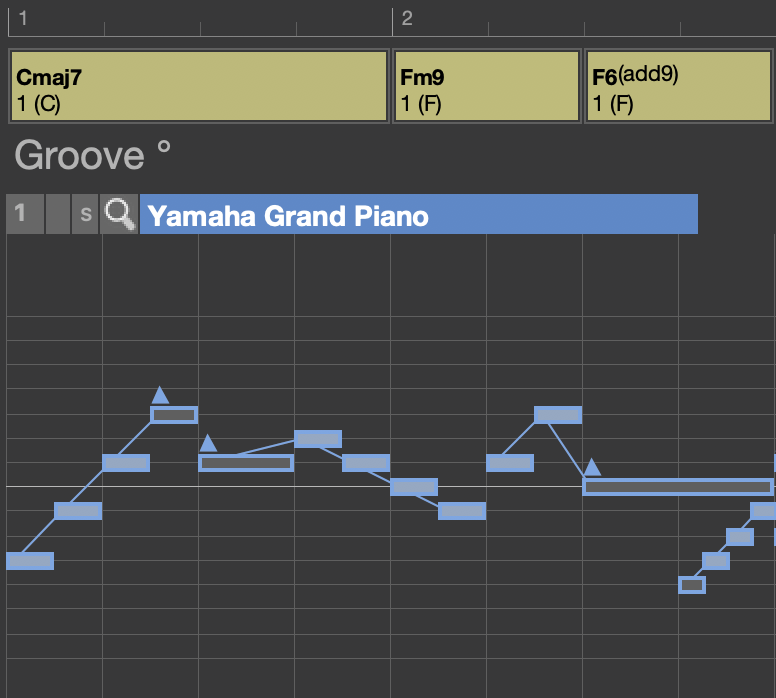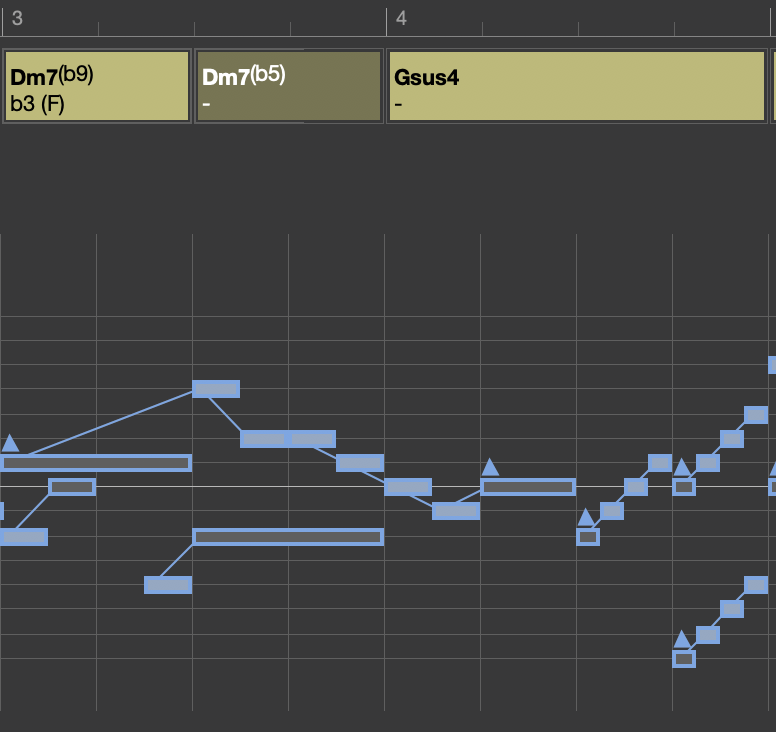
Posted
Another short demo made by flipping, reversing and stretching a few melodic figures over a groovy accompaniment provided with the example libraries of SF.
groove_0.mp3
Mo., 04.03.2019 - 23:17 Permalink
The trick is more or less the same of my previous demo "Jazzy Stuff".
As you can see, measures 3-4 are the mirror of measures 1-2 reversed, flipped and stretched (on last 2 beats of maesure 4).
Nothing of revolutionary but always effective :-)


Mo., 04.03.2019 - 23:20 Permalink
If someone wondered how long it took, well: a few minutes. Once harmony has been defined, Synfire is lightning fast in coordinating the Figures with the chords. All the rest is pure fun :-)
Di., 05.03.2019 - 13:34 Permalink
Thanks for the example.
I'm currently working on ways to automate these kind of transformations, so you could, in an instant, turn some prototype melody into a full counterpoint part for multiple instruments. And with every click of a "Next Suggestion" button, you'll get another one.
Di., 05.03.2019 - 14:04 Permalink
Great, Andre!
What about extending Flip and Reverse commands even to chord progressions?
Di., 05.03.2019 - 17:54 Permalink
@Andre
New version of groove.
Chords in bars 8 and 10 should be named Cb, being them borrowed from Db mixolydian: is there a way to change enharmonically the chord names?
groove.mp3
Di., 05.03.2019 - 19:14 Permalink
This one works much better. Nice. I'm doing some research at the moment on the correlation of melody and rhythm. Difficult stuff. Rhythm is at least twice as complex as harmony, it seems. We need a good model for that, which is not dependent on style. If we find one, rhythm could be expressed in an abstract form, just like Figures.
What about extending Flip and Reverse commands even to chord progressions?
It's already there ;-)
Di., 05.03.2019 - 22:30 Permalink
It's already there ;-)
oh! Really? Must take a look now!
Di., 05.03.2019 - 22:44 Permalink
can't find it :-|
EDIT: got it! Cmd+left arrow?
Di., 05.03.2019 - 22:53 Permalink
Well, that's remarkable...
groove_negative.mp3
groove_negative_inverted.mp3
groove_inverted.mp3
Mi., 06.03.2019 - 00:54 Permalink
That's some really interesting groove studies. Well done!
On the topic of "unusual" workflows: Did you check out my "Ohne Sinn und Verstand" video which shows some extremely weird "possible but not intended" workflows with Synfire (using Shift templates as Figure sources, mirroring chords and other even stranger stuff)?
Mi., 06.03.2019 - 10:25 Permalink
On the topic of "unusual" workflows: Did you check out my "Ohne Sinn und Verstand" video which shows some extremely weird "possible but not intended" workflows with Synfire (using Shift templates as Figure sources, mirroring chords and other even stranger stuff)?
Not yet. I’m currently busy with my yearly flu, fever, headache etc; but as soon as I feel better I’ll definitely look at it :)
thank you!
Mi., 06.03.2019 - 10:43 Permalink
Get well soon, Roberto!
Mi., 06.03.2019 - 11:16 Permalink
Oh, if it's THAT flu currently crossing Europe, I've had that in January already. It's unusually hefty. My entire family was knocked down and our senses took a long time to fully recover. Be good to yourself and recover soon!
Mi., 06.03.2019 - 12:12 Permalink
Yes, Andre, I think it's the very same treacherous virus.
The good news, if you can say so, is that the unusually mild weather has weakened the virus and the fever does not rise too much...
Thank you guys :)
Mi., 06.03.2019 - 16:27 Permalink
@Andre who made the grooves for the example libraries?
Mi., 06.03.2019 - 17:58 Permalink
The figures were modeled after recordings done in my studio decades ago. Originally there are only a few of them, so I used exactly the transformation tools we are discussing here to create more varied styles. This involved a lot of manual labor, so unfortunately it's not scaleable. That's why we're looking to automate phrase generation with AI.
Sa., 09.03.2019 - 00:02 Permalink
@HiEnergy on tomorrow I'll watch your video(s).
Have you already tried to cut one or two chords at the beginning of a harmonic progression and paste them at the end? This will completely change the meaning of the verse or chorus or whatelse, with often surprising results.
Synfire is particularly suitable for this kind of intricate operations... 8-o
Sa., 09.03.2019 - 11:26 Permalink
This will completely change the meaning of the verse or chorus or whatelse, with often surprising results
Absolutely. This also contradicts the popular expectation that there is such a thing like the "best next chord". We often get asked by beginners how to best find out the "next chord". Well, this is much akin to a novel writer asking for the "next sentence" to their story.
While there is a continuation color scheme for the Palette, it only reflects what was most commonly used in a thousand or so popular tunes. If it wasn't so popular, I would remove it. A better workflow is to lookup a song book (or the Harmony Examples library) and do some transpose/copy/paste with snippets taken from it and listen what surprising ideas you get.
Sa., 09.03.2019 - 18:46 Permalink
The mirrored harmony of a common, aka "popular", progression (just a bit manipulated by cutting a pasting in different places some chords) produced the attached mp3.
Here and there, one hears some odd notes, but the result gives, in turn, a number of new ideas to be cut, saved into a library and re-used in other works.
Synfire, as a generator, is a mine of very often usable stuff.
notbad.mp3
Di., 12.03.2019 - 04:07 Permalink
@Andre, that sounds like a great idea.
Di., 12.03.2019 - 12:49 Permalink
A better workflow is to lookup a song book (or the Harmony Examples library) and do some transpose/copy/paste with snippets taken from it and listen what surprising ideas you get.
Agree. It is the best gym to learn how to use Synfire.
The attached file is made only with clips taken from the example library (except for a little melody in the middle register from 0:22 to 0:34 circa)
libonly.mp3
Di., 12.03.2019 - 13:10 Permalink
If you run the file libonly.cognac, notice how the figures do not move an inch from one container to another: the musical logic is guided by the harmonic context (chords+scales), and Synfire takes care of calculating the pitches and the relations between them



